Archive for category Animation
Warner Brothers’ Storks Film Carries More Weight Than Just Babies
Posted by Admin in Animation, Film, Uncategorized, Writing on June 14, 2017
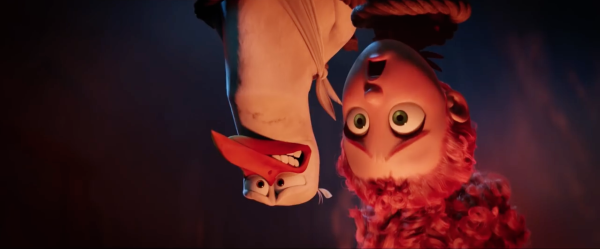
Storks received some minor attention when a Twitter account pointed out a montage from the film showcasing various couples – and singles – receiving babies from the flying avians. The recipients were of various races, ages, sizes, and sexuality. It was a slight scene, and it was really only for those who would take notice, but it still was worthy of attention. Storks seems like it’s part of the not-so-great trend of films playing minor favors towards progressive ideals – a sentiment that feels more like a “spot the trend” game than any real sense of modern acceptance of diversity. Storks, a movie as a whole though, is genuinely more interested in those progressive ideals than a tossed-off montage. Storks is generally dismissed as a non-essential children’s film. But it’s a funny, clever, self-aware bit of animated goofiness with its heart firmly held in its silent, but meaningful, progressivism.
Storks, at the onset, feels like its a film about nothing, really. It’s the off-beat, quirky story of a stork at a company, which no longer delivers babies, teaming up with a orphan human girl, to do just that. The movie runs through an assortment of wacky set-pieces and silly characters via a plot that on its surface is rather simplistic and superficial. Its reliance on heavy cartoony antics and self-aware gags can be a turn-off to a lot of people who prefer their animated films to be more grounded and sophisticated (an approach I find limiting in a lot of ways but that’s a topic for another day). Yet underlining all of that silliness, Storks exhibits a real sense of confidence in its characters and in its setting – a confidence that is exploratory and distinctive, noticeable with a closer look.
I hate saying this, and I hate how this will sound, but I need to say this only in order to clarify it: Storks is arguably the most “millennial” movie I’ve seen in a while. It’s a film in which its absurdity and irony attempts to, but doesn’t quite, mask its dramatic exploration of the confusion of life and complications that younger “20-somethings” face. It’s a film that comically but quietly explores their contemporary search for purpose and identity – in a wildly basic way, but in a way that feels necessary. Storks wears its heart on its sleeve. It is quietly, narrowly honest, but that honesty is cluttered in self-awareness, funny voices, and physical comedy – the kind of way in which millennials tend to approach their futures.
It’s tricky, almost dangerous, to explain myself without stereotyping, but hey, I certainly wouldn’t be the first critic to speculate on “what millennials are” these days. In my experience, I find that this particular upcoming generation is more honest and forward than the previous one, but often diffuses that honesty through irony, asides, and forced comedy. (You know, memes.) Storks isn’t a “meme” movie, in that it didn’t inspire an array of JPEGS and GIFs tossed about on social media, but its core sentiment is easily lost in its nonsense. One could suggest that the film’s failing is exactly that – its sentiment is belittled by its chaotic cartooniness. But I feel like that’s a shallow reading of cartoon antics in general, an implicit denial of letting cartoons be cartoons. That is to say, all of those antics don’t deny the film’s sentiment, even if the characters aren’t the utterly raw, broken characters, like the ones in Bojack Horseman or Rick and Morty. The cast of Storks are lost in deeply confused, deeply aimless ways, composed of characters who are coded in youthful exuberance and confidence but not necessarily a purpose: Junior the stork (note the name) is up for promotion without any idea as to what to do when he gets it, while Tulip the human is a literal 18 year-old orphan who has no idea who she is or where she belongs.
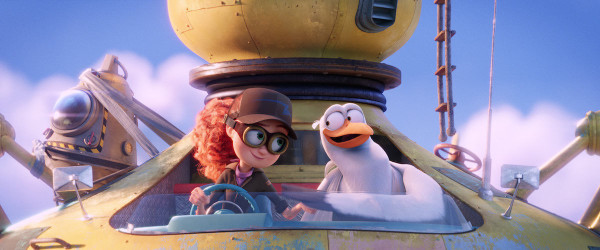
Storks is somewhat atypical of most animated movies in that it places much of its stock on those two characters for a good portion of its runtime. All the physical gags and loose plotting is secondary to the film’s confidence in the interplay between Tulip and Junior, and essentially the voice artists Katie Crown and Andy Samberg. And it is a delightful pairing. Crown and Samberg work off each other so well that it almost feels like certain scenes were added and/or extended just to pad their interaction. Their comic conflicts and camaraderie move fast and sharply, due to the power of two actors on top of their game. Yet even through those comic interactions, Samberg and Crown don’t deny or ignore the complication of their characters in this weird, specific moment in their lives; they instead manage to exude their current turmoil through their hilarious performances. It’s not nuanced, but millennials aren’t particularly nuanced (and I mean this positively). Just because someone posts a meme that dumbly describes their current feelings doesn’t negate the fact that they’re indeed feeling that feeling.
It’s immediately present early in the film, when Tulip gleefully asks Junior to stop calling her “orphan Tulip”; she comically, but bluntly, describe how the term “hurts her heart.” Later in the film, Tulip teases Junior over his ideas on what he would do once he’s promoted. After a bit of inane, silly prodding and subsequent deflections, Junior reacts in anger: “BACK OFF” he screams. It’s a hilarious but personal response to his dilemma – what does he truly believe in? What is his personal drive upon “earning” his position, and what will he do when he achieves it? Junior is terrified of self-reflection; throughout the film, he blindly recites the corporate slogan, he sings the commercial jingle to a baby, and he grows excited over Storkcon, a convention in which its cleverest innovation is a spherical box.
I don’t think millennials aren’t especially hostile to capitalism, so much that they’re more readily and willing to question and criticize it. “Climbing the ladder” is still the goal of many young people, but as it becomes clear that such an achievement is more complex and fraught these days (financially, socially, and mentally), millennials at the very least need a real sense of purpose within the system that goes beyond “it’s just what you do.” Junior’s mind literally explodes when he gets that promotion early in the movie, yet the story showcases his reluctance to articulate what, exactly, he would want to do once he achieves this. Tulip’s assured ideas push back against Junior’s smarmy question over what she would do in his position, but it also reinforces how specifically lost Junior is in this particular point in his life.
Speaking of Tulip: I just have to say that the Storks’ co-lead is a fantastic character. She pulsates with such life and personality, a funny and quirky being who also shades a lot of complexity in her actions and her vocal performances – and in her animation. Tulip is a brilliant young girl who never is given her due: she invented (and fixed) a flying machine that doubled as a boat after a plane crash, and her rocket packs actually work before one of her test subjects take things too far. (You then want to question whether “Tulip’s help” really was the cause of the company’s low profit margins.) Let’s be blunt: there’s a clear, prescient feminist message here. A smart, capable woman whose ideas are dismissed, who can’t even be seen as a real person without the “orphan” qualifier? Really, there’s enough here that could fit an essay on its own. (This also ties into capitalism’s problematic approach within a social context, but again, that’s worthy of its own, separate critique.)
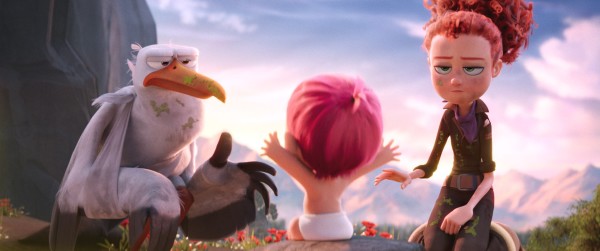
What we get here, through the overall tale told in Storks, is two young persons of different lives (and species, which winks towards its own idea of a diverse co-lead setup) who struggle with modern ideas of personhood and livelihood, all while engaging with the ultimate symbol of the classic “success” traditional ideal: the baby. And here is where things get interesting. Junior and Tulip fit within a particular archetype. A young couple, both of different worlds, who find themselves suddenly in the care of a child, neither of them ready to care of it, let alone care for themselves. They’re literally figuring it out all their own. In this way, Storks attempts to bridge traditional ideas of social success while questioning it all the same.
And, to be very clear, Storks isn’t a movie that’s going to delve heavily in such an idea. It’s silly, audaciously funny, with the kind of animated physicality that rivals Tex Avery for delightfully dumb cartoon exaggeration. The last CGI film to do something of this caliber is probably Madagascar 3 (one of mistakes of the Penguins of Madagascar movie was arguably to pull back from that gleeful embrace of cartoon exaggeration). Storks delights in its visual nonsense: its bird characters with hilariously perfect teeth; it’s fun, revealing montage of Tulip’s cast of imaginary workplace characters; it’s most sharpest creation in the form of a male wolf couple (wink) who fall in love with the baby and commands its pack into sheer physical recreations of bridges, mini vans, and submarines.
But those exaggerations do not (and should not) distract from its richer, well-considered points; they reflect millennial confusion and fears over how to approach a society that continually questions the nature of livelihood and family. Storks feels like a movie in which its creators almost lucked into devising a smartly considered world and a thematic heft that balances the film more than its previews indicated (and which hinders its third act a lot, which I’ll get to in a bit). In Tulip’s brief idea, suggesting the company they work for invest in a more diverse set of birds and animals, Storks sparkles with potential of a world in which its animals have as much life as its humans. It’s present in the wolves and the throwaway scene in which Toady interviews a bunch of animals. Storks enjoys the world it created and meta-commentary that flows from it.
This, in some ways, is also reflected in the scenes involving Nate Gardner and his family. Here, tradition again is questioned, if perhaps not as rigorously as it is with Tulip and Junior. It’s as cliche as it comes when we see two overworked parents consistently neglect their own kid, but at the very least, Nate thrives with a clear self-awareness of the situation, as in with the scene where he guilts his father to help him built the baby-catching contraptions on his house. Storks smartly doesn’t dismiss out of hand traditional ideas of success and family; it simply requests that its characters understand why it wants to achieve those goals, and be assured in that achievement. Note that Tulip and Junior do NOT fall dotingly in love with the baby and automatically become a family. The wolves’ are seen as in the wrong for this behavior, and so is Jasper, who realizes his ultimate mistake (falling in love with a baby just because its “cute”) and resolves to return to just finishing his job.
This is Junior’s ultimate lesson, which he recites (ironically, when he recontextualizes Cornerstore’s slogan into a personal mandate) when he finds himself in a factory filled with babies and an assortment of unemployed storks around him. This is also Storks’ weakest moment; its third act is lost in its perfunctory need to create an over-the-top climactic moment (if you watch carefully, Tulip and Junior don’t do anything but watch the chaos unfold in the entire sequence). A friend of mine commented on the need to kill off (and, for all intents and purposes, he is killed off) Hunter when he just wanted to protect his company, and he has a point. Turning Hunter, an antagonist who just had a strict corporate/capitalist mandate, into an out-and-out villain was a mistake, but you definitely get the sense that even the filmmakers felt ambivalent about it. (This more or less is notable in their approach to Toady, whose antagonism and motivations are hilariously, and purposely, unclear; Tulip and Junior barely grasp his role in the chaos that unfolded in the end).
Storks is infinitely more interested in the kind of silly, cartoonish world it created and the lost, confused characters who inhabit it, who open up to their insecurities through funny voices and dumb expressions, but whose insecurities are still present and significant. In its final moments, Storks showcases the myriad of families, and family types, who embrace their babies (many of whom could indeed never get babies the traditional way, something a “woke” sequel could really delve into?). It provides Tulip her rightful family, but more importantly, it gives her a sense of identity (family) and purpose (delivery of the baby). It also provides Junior a sense of purpose (embracing baby delivery at Cornerstore.com) as well as identity (Junior was never as lost in knowing who he was as Tulip was, but establishing a personal connection with her, and her family, does seem to provide him a level of peace he never knew he lacked). As heartwarming it was to see Tulip and Junior embraced by Tulip’s family, it was also right, perhaps even more so, to see the two of them nod at each other confidently in the workplace, confident in their new role.
Why Bunnicula Is One of 2016’s Best Animated Debuts
Posted by kjohnson1585 in Animation, Television, Uncategorized, Writing on April 12, 2017
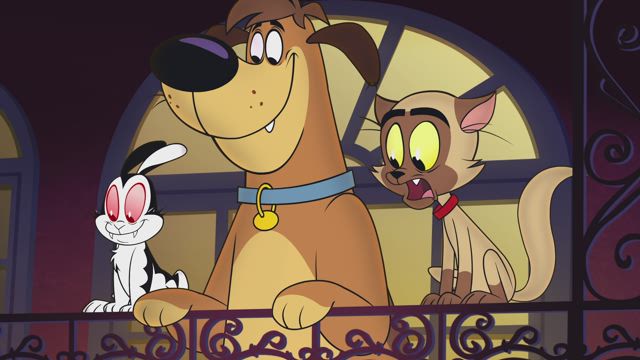
In 2016, Cartoon Network attempted to rebrand Boomerang, its sister channel that airs an assortment of classic cartoons and nostalgic ’90s productions. Along with the newly-fashioned logo, Boomerang broadcasted three new shows: Be Cool, Scooby-Doo, Wabbit, and Bunnicula. Be Cool, Scooby-Doo, which I reviewed here, was clearly meant to be the flagship show to capture new viewers for the “new” channel. Scooby-Doo fans are a quiet but dedicated bunch, and their eyeballs would help steer the channel in positive direction. Wabbit, the newest iteration of the Looney Tunes franchise, was essentially the version of what The Looney Tunes Show was originally meant to be. Its use of classic characters and short-length format would fit perfectly between old and new shows, and meant to appeal to those (dwindling) fans as well. Then there was Bunnicula – a curious show based on the classic book series of the same name. There wasn’t much of a big push for this show, certainly not in a way that would scream “check out the new Boomerang!” It’s hard to say what role Bunnicula was supposed to be in the overall rebrand, but it’s clear it wasn’t supported but CN bigwigs.
The rebrand was, for all intents and purposes, a failure. Be Cool, Scooby-Doo brought in its fans but they weren’t sitting around for the overall Boomerang change-over. Wabbit struggled to grasp the kind of manic energy that the best Looney Tunes works could muster; its skinny designs and muted color palette didn’t help much either. And, again, there was Bunnicula. The off-kilter cartoon by Jessica Borutski and Maxwell Atoms had a less-than-average pilot and made an strange choice in casting Sean Austin to voice Chester and Chris Kattan to voice Bunnicula – the latter of whom barely speaks any actual words. Using non-typical voice actors to voice cartoon characters is a fairly dangerous move, and that pilot suggested some basic, cartoonish antics – Tom & Jerry-level slapstick within a soft-horror atmosphere. Nothing suggested it was worth watching, in other words. But it’s now clear that this was all set-up. Bunnicula quietly uses its pilot and subsequent episodes to build a genuinely creepy and funny show that manages to depict three specifically-cliched characters with layers of complexity that become more and more noticeable over the series’ run.
[As part of a sudden new approach to Boomerang, a number of episodes have been placed on its online streaming site, which requires a paid subscription. Time will tell if this will be more effective than their cable rebrand attempt.]
It’s common for characters in cartoons to exhibit various stock traits that are utilized to incite conflicts that lead to comedic set pieces or low-key dramatic beats. The story usually take precedent, in which characters’ personalities and behaviors butt up against other characters’ personalities and behaviors, or some broadly ludicrous situation. The sillier the cartoon, the more exaggerated those traits will be. Traits may be slightly adjusted as episodes go along, but there’s rarely much examination on why certain characters are the way they are. The nerd kid is the nerd kid. The spunky gal will always be the spunky gal. The stupid goofball is, unfortunately, the stupid goofball, day in and day out. Bunnicula is different. It definitely exhibits the exaggerated energy of a silly cartoon, but it puts more careful consideration into its characters (particularly Chester and Bunnicula, but Harold as well) than you might expect. Bunnicula, on the surface, is about a scaredy-cat, a dumb dog, and a carefree demon bunny getting involved with wacky situations. Bubbling underneath is the story of a family of pets with strong, personal, problematic traits that they gradually work through so as to try and be there for not only each other, but for their owner as well.
Bunnicula is a far cry from its original source. They’re not old-hat pets owned by a boy and his family, but semi-new pets procured by a young, tomboy-ish girl named Mina and her father. Chester, Harold, and Bunnicula know each other of sorts, but it feels like they’re still getting the hang of being around each other, and around Mina. They clearly love her, but they’re working through the particulars of what that entails, particularly Bunnicula. They’re also working through how they exactly feel about each other, as their comic traits are used to mask or distract from their truer feelings for each other. All of this takes place within a New Orleans locale (an inspired setting to be sure), filled with various kid-friendly (but still creepy) horrors and monsters. Yet in the midst of all that, these three pets seem to grow… well, if not more fond of each other, at least more understanding of each other and themselves. They incrementally discover that their base traits are something that they need to work on and work through – not just specific traits for the comedic sake of it. (Even in the chaos of the pilot, “Mumkey Business,” it’s clear that Bunnicula expresses a slight change of heart towards Mina, upon realizing his causal associations with dangerous creatures could harm her.)
Bunnicula, at the base level, thrives on an old-school cartoon charm and sensibility. Molded off the basic premises of Hanna-Barbara cartoons (particularly Tom & Jerry), Bunnicula visually and narratively exhibits an artistic design that would be at home in the ’40s and ’50s. Harold is a clear homage to Scooby-Doo himself. The characters’ hands can transform from animal paws to actual gripping fingers in an instant. Characters pull items out of nowhere from behind their backs and possess pockets in their fur whenever they need them. Physical, violent humor is the norm, if not as extreme as those classic shorts were. It’s righteously self-aware. Chester, Harold, and Bunnicula function on a single trait that instigates, or mitigates, the plot. It does Wabbit better than Wabbit does Wabbit.
Yet unlike most classic shorts, its three leads are driven, at a base level, by genuine love. It’s probably the first cartoon of its type where characters actually say the words “I love you” to each other, even if after the stress of a crazy story. It’s a show where its cast deeply care about each other, even if they have to be reminded of it. Their endgame protection of Mina from the disturbing creatures around them keeps them successfully grounded, even when their intrinsic traits push them to their extremes. Bunnicula himself is wildly amused by these horrible creatures, but needs to reminded of their danger to Mina (and by proxy, Chester and Harold). Eventually, he calms down. Harold is less complex – a simple dog who often gets the buffoonish jokes, but he also is more emotionally open and honest. He’s the first one to express love for others and to whom Bunnicula and Chester most likely express their affections. (This is most notable in the episode entitled “Bearshee,” where Harold plays diplomat between the easily scared cat and a confused, frightened ursine specter.)
Then there’s Chester.
Using Sean Austin as the voice for Chester in retrospect was a good idea. Austin captures that over-the-top energy that’s often required from the character, but he also manages to nail a sad vulnerability in the character that becomes clearer in each episode. Chester’s fears are both exaggerated and sensible, but also weirdly indicative of something, perhaps, darker and lonely. (Nothing exemplifies this more than his final speech in “Chester’s Shop of Horrors.”) He often desires to be a human (“Curse of the Weredude,” “Nevermoar”), for example, and it’s tricky to tell if it’s just to escape being a cat, escape being afraid all the time, or to be respected for his “true” self. (Arguably, it’s all three.) He desires the simple, finer things: a good crossword puzzle, beat poetry, riddles, sci-fi. He’s also kind of a control freak, but it’s not driven by an inflated sense of self-worth – not entirely. It’s really to have some sense of control over his own life, in a world of random terrors and horrors that come to afflict him and his world (darkly captured at the end of “Puzzle Madness”). At times he will go overboard, torturing Bunnicula or deeply believing he deserves good luck at the expense of others’ bad luck. Chester’s fears and insecurities aren’t wrong, His reactions to them often are, but also, he can’t help it.
Chester, Bunnicula, and Harold are who they are, and Bunnicula takes care (for the most part) to make sure their actions and attitudes make sense, that even when they butt up against each other, that it’s all part of a “larger” struggle to find common cause or affection among each other. Bunnicula shows that that kind of emotional camaraderie is a hard thing to do. There’s no grand epiphany – partly because if there was, there’d be no show. But there is a gradual, tedious, comical struggle for the characters to accept each other, and their flaws, and their insanely divergent personalities. Bunnicula is about how love trumps all, even within the context of a wacky cartoon, but it also shows how tricky it is to let that love win out, especially towards those who represent things you don’t even stand for. There’s real affection between the characters, but it’s hard for them to see it, and the show somehow makes it fun to see them try.
Tip from Home: Adventures with Tip and Oh is the Young Black Female Lead We Need Right Now
Posted by kjohnson1585 in Animation, Television, Uncategorized, Writing on August 24, 2016
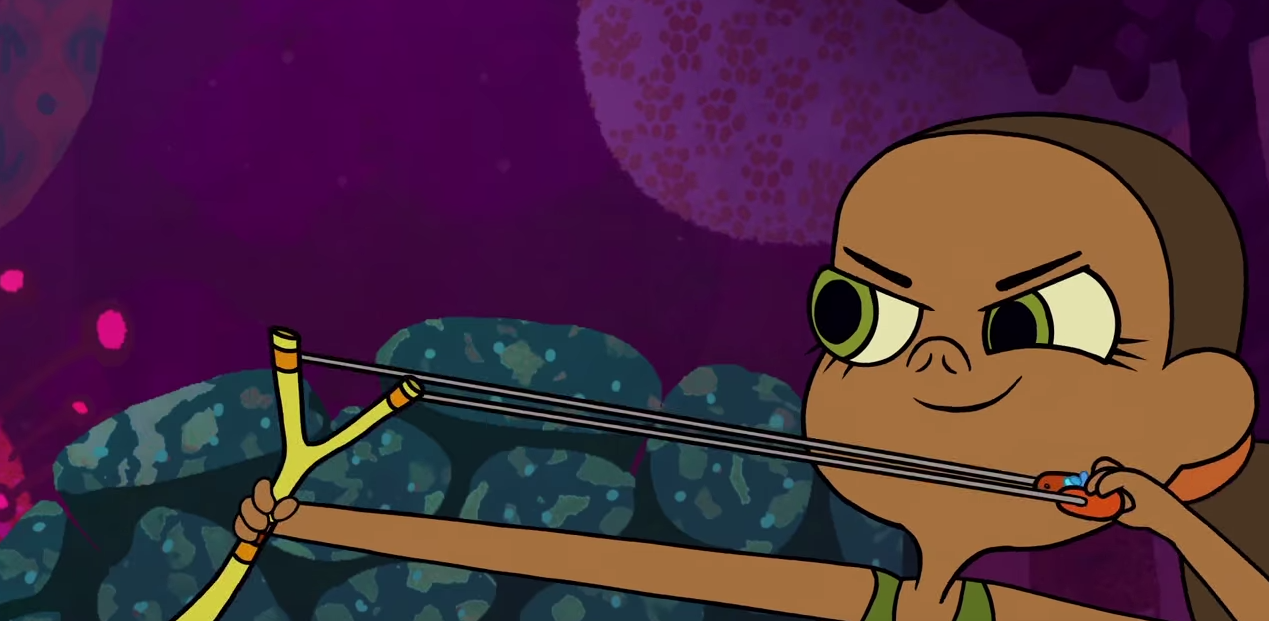
Home: Adventures with Tip and Oh is based on the Dreamworks film Home, a buggered, incomplete piece of animation that never quite grasped the satirical edge needed to portray the abject and complete removal of citizens into makeshift suburban prisons. Home cared little about the uncomfortable connotation of such a premise, which resulted in a plot – in which a young black girl teams up with an alien outcast to try and find her mother – that could not shake off its racially-coded baggage. I know. I know. I wish I could just ignore the analogies – the wholesale removal of people from their homes, the wholesale removal of African people from their continent, the constant splintering of slave parents from their children to foster an economic system that possesses ramifications that last even till this day. But what you need to understand is that it is so, so hard, and Home did little to ease that discomfort from my mind.
In that regard, I had very few expectations of this show.
If a Home TV series had to be made, the best bet would be to ignore that entire premise and forge onward with new, unrelated storylines. Adventures of Tip and Oh does for the most part, although the occasional exploration of the Bov’s cinematic past actions is as awkward as you’d expect (more on that later). The animation is decent; the character designs are off-putting, as typical of Thurop Van Orman’s style, but functions well enough in movement, and viewers will find themselves getting used to it fairly quickly. The character choices are fairly trope-y and questionable, with Donny being a Mr. Krabs-esque non-entity, Sherzod gearing up to be the most decisive character in a while, and Lucy exhibiting a certain level of air-headedness that doesn’t seem to fit a single mother living in Chicago. These, and other creative decisions, suggest the writers are still working through some issues, but there is one thing that Netflix’s new show has right: Tip herself.
I didn’t warm up to Gratuity “Tip” Tucci at first. She seemed a bit all over the place. She is inconsistent, a bit aggressive, a bit loud, a bit too weird – especially compared to her cinematic counterpart. But then I realized something: that is the point. Tip is purposely, uniquely, her own girl. She is an eighth-grader who possesses her own very limited, very vain, very specific point of view. Her aggressiveness, loudness, and weirdness is uniquely her own. The writing doesn’t quite do her any favors, specifically in terms of the situations that she finds herself (and Oh) in. But Tip herself is special. She is unabashedly herself, not particularly concerned to fit within the parameters of young girl character templates – specifically, young black girl characters – that came before her. She is Penny Pride – clever, determined, confident to a fault – mixed with Star Butterfly – extroverted, adventurous, out-of-her-league. Tip is confused, lost, conceited, goofy, and, yes, even grating. She is all those things – which makes her the best, most important young black female lead for children today.
I need to reiterate something: other than Doc McStuffins – a show for preschoolers – we do not have a single animated show on the air with a black girl as a lead. Mostly cartoons are driven by young boys (or talking animals). There are more shows now with girls as leads, and/or shows with strong feminine characters. But they’re mostly all white (save for Steven Universe’s Garnet, which is another matter entirely). And that is fine. But in this era and in the call for more diversity, it’s telling that, as usual, young black girls are continually, routinely ignored. (Full disclosure: I pitched this piece to a well-known site, which was rejected, and which I deeply believe contributes to this problem.) Seeing and experiencing someone like Tip on my screen felt revelatory. It made me realize how limited in scope my expectations of what young black girls could be. (Note I didn’t say “what black girls should be,” which is an extremely important distinction.) I love Tip because, sometimes, I don’t love Tip. I love that she’s sweet and loving and naive and annoying and too much and quirky and super-weird and sometimes “uppity.” Black girls need to see this. We all need to see this.
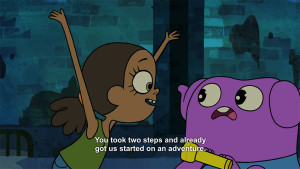
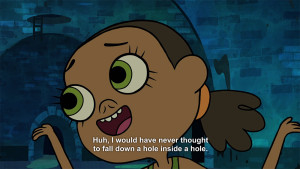
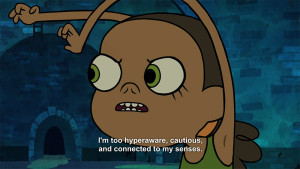
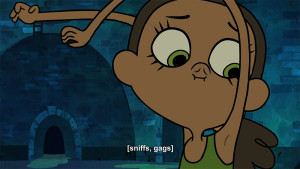
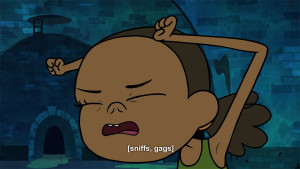
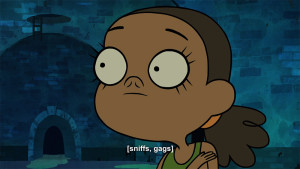
This scene epitomizes the kind of person Tip is as a character. There’s no contextual reason why she sniffs herself (they’re in a sewer, but there’s no reason why she sniffs her armpit versus any other part of her body), but it shows her her spirit, vanity, and goofiness all in one brief monologue.
Tip isn’t African-American. She’s Caribbean-American. Her grandparents immigrated from Barbados; Tip is second-generation. The show doesn’t play around too much with this, although it is nice to see when they do. (I would love to see more Barbados-inspired bits on occasion, in the fun ways that Sanjay & Craig sometimes played with its Indian-related bits.) I don’t expect the show to really do that, though, mainly because the writers don’t seem to really grasp the full relevancy of what they have in a character like Tip. There’s theoretically a lot to unpack in a show in which the Bov implemented forced displacement and occupancy, where the setting is Chicago, and where Tip and Lucy live by themselves sans a father figure. When Tip’s grandparents visit in “Wrinkly Humans People,” that awkwardness is palpable, but the writers don’t see it. After all, her grandparents deeply distrust the Bov for what they did, and you honestly can’t blame them. Yet the show works it so as to suggest that it’s her grandparents that are in the wrong, that they’re the ones who are, essentially, the bigots, since they just can’t get over what the Bov did. Well, of course they can’t. History is ugly.
Even still, there is potential here. There is a rich complexity in the idea of Tip’s broader acceptance of the Bov and, specifically, Oh, and how that comes up against the reality of what the Bov did. There is perhaps something to how easily a young Tip has forgiven the Bov in order to maintain the stability of her small family unit, and how that continues to push up against those still harboring resentment towards their occupiers-turned-neighbors. It would be deeply interesting to see episodes in which Tip has to, in some way, address how she justifies her love for Oh, as opposed to her past hatred for the Bov’s role in separating her from her mother. Adventures with Tip and Oh might have been better served ignoring all that overall, but although I do applaud the show for dipping its toe into the thornier sides of the film, I doubt the writers have the temperament to hit such dramatic notes.
That’s a dramatic layer way out of reach for this crew. At this point, in its first season, it would be just enough to take a fun, deep look at Tip herself (in the context of a young black eighth-grader with only a mother living in Chicago). As a unique character, the writers provide her with the variety of traits that I’ve mentioned earlier. As a character who will be developed, that where the writers fall short. It’s tricky, because the show doesn’t need to be an in-depth (if silly) examination on what it means to be a young black girl in Chicago – aliens or not. But it would be worth exploring some of the issues unique to that worldview and experience. The clearest example of this dilemma lies in “Angerdome,” an episode in which Tip deals with her anger. There are volumes of content that could be written that explores the social exploitation and discrimination that exists within the “angry black woman” trope. It is both vicious (which posits all black women as unstable and prone to violence) and commodified (from the lighter-but-overused “sassy” trope, to pushing their angry reactions on reality TV). It’s hard to say how the writers see all of this in “Angerdome,” though. There’s a moment, after various characters tell Tip to calm down, where she proclaims, “I’m allowed to be angry!” and it is wonderful; filled with the personal, determined, defiant spirit that young black girls need to hear. Yet the power of that statement is undercut when, immediately after, Tip resigns to needing help (and an outlet) to deal with her anger.
That’s what makes it hard. There is the real, distinctive lesson which allows kids to understand that having an outlet to deal with anger is important, and I can’t fault the show for dealing with that (although the answer they come up with is muddled). At the same time, the show mostly ignored the opportunity to explore Tip’s individual struggle with what it means to be a black girl who gets, and is allowed to be, angry. It’s a powerful statement that the writers fail to notice as a powerful statement. It’s part of the overall verve of the show, really. It’s great to see Adventures with Tip and Oh use a character like Tip to have fun with the general complexities of childhood, especially within such a specific premise. It’s tougher to see this done separate from the unique characteristics and history that Tip (and the show) embodies: the black, only-child, fatherless, Chicagoan setting. The universal ideas are fun, and pushing them through Tip is wonderful, but the writers have an opportunity to really explore Tip’s experiences at a personal, raw level, and I don’t think the writers see it – or they refuse to.
Still, I praise the fact that a character like Tip exists. She is simultaneously fun and frustrating, and it makes her necessary to see a character like her on television. What ever issues or concerns that may happen around the lives of the Tuccis (which, for all we know, could be fixed by season two), Tip’s goofy, abject, unforgiving weirdness and quirkiness – so often contributed to white women to the point of a dated, oft-misunderstood trope – has been finally applied to a young black girl. It’s just good, refreshing even, to see a black girl outside of a typical “no-nonsense” role. (Tip is no-nonsense, but it’s defined within her weirdness, not as a sole contrast to those “silly” white kids.) A lot of her appeal is due to the voice artist, Rachel Crow, a 2011 X-Factor contender taking the role from Rihanna from the movie. Rihanna had gumption, but at best her voice work was merely passable. Crow brings a serious, specific attitude to Tip – a rough energy that’s wonderfully infectious (in the same multi-layered cadences that the late Christine Cavanaugh gave to Gosalyn Mallard). She also has a distinct singing voice that manages to add flavor to both the show and the character, without it being too distracting or random.
So flaws and all, I look forward to see where Home: Adventures with Tip and Oh takes Oh and Tip in future stories. The creative critic in me wants to see the show lean a little harder on its premise, on its boundaries and issues, just to see them contextualize how Tip might respond to those tougher dilemmas and grow as a person. I would love to see those issues hit upon, to expose it to kids, particularly young black girls, who struggle through those issues every day. As for now though, I just want to see more Tip. I want to see more of her odd, assertive, annoying behavior. I want to be challenged, bothered, and amused by Tip’s antics, because I want young black girls – and all viewers, really – to understand that being like Tip is okay.
(Final note: I know this is “just a cartoon.” I know I should just enjoy it for what it is. What I’m telling you is, I just can’t. Not with what I know and experienced, not with what I’ve read, not with the history and context of this country and even Chicago itself inside my head, not with the news stories and the personal accounts of people’s experiences shared every single day. I physically, emotionally, psychological cannot separate the two. I can only channel it, and I would hope and love to see Home: Adventures with Tip and Oh do this as well.)

